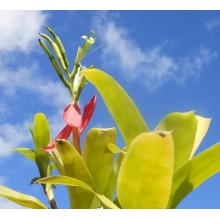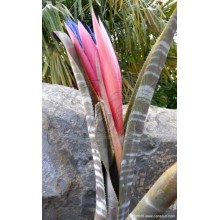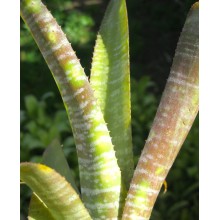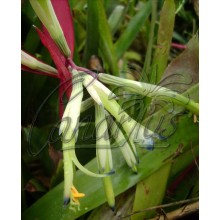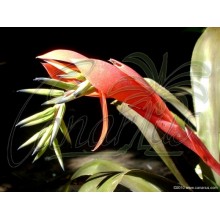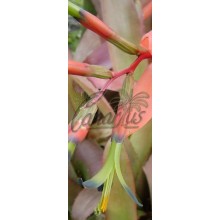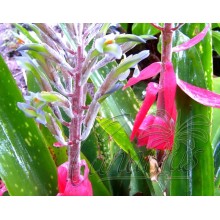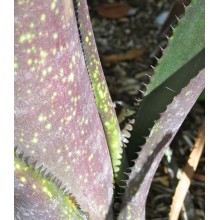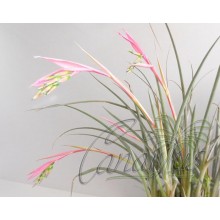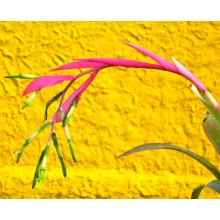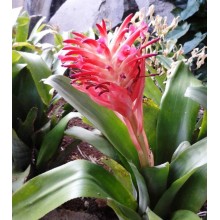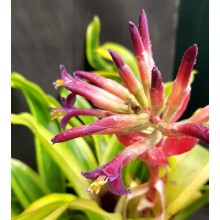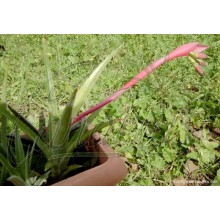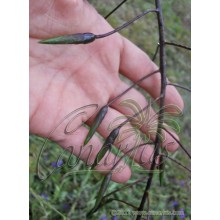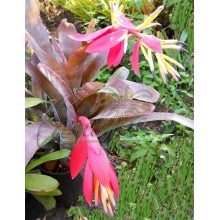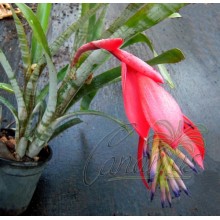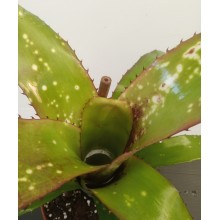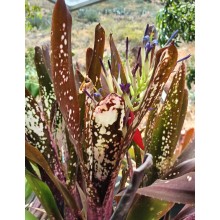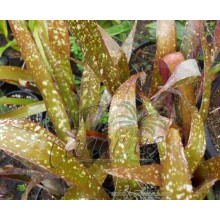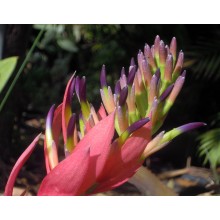Exotics There are 1155 products.

Exotic plants are species from other parts of the world, and they usually have ornamental qualities: a lush foliage, colorful flowers, unusual shapes... Here you can find a great variety of exotic plants: from Bromeliads and Heliconias, to pamls and houseplants.
Exotic plants do not have a particular use. Collectors buy this kind of plants for their rarity, for indoor or outdoor decoration, depending on their features.
Subcategories
-
Bromeliads
Bromeliaceae is a large family of herbaceous plants native to the Americas. Just like many orchids, they naturally grow on tree branches or above rocks and cliffs. Bromeliads are highly appreciated because of their incredible colours and their ease of growth in pots.
We offer a fine selection of bromeliads that are never available through garden centres in Europe. Large scale distribution mostly sells green, thin-leaved hybrids. Our shop keeps an ever-increasing offer of the species with the toughest and most colourful leaves, better adapted to hot and cold conditions of outdoor life. All our bromeliads are shipped as bare root “pups”. These are the robust basal suckers produced after blooming. Bromeliads travel amazingly well in the mail and they are also cheap to ship. Our robust pups will often bloom in less than one year.
-
Aroids
The botanical family Araceae, is popularly called Aroids and includes about 3750 species. It abounds in the tropics and holds the most spectacular diversity of leaf shapes and textures. The large genera Philodendron and Anthurium are symbols of the American rainforests and they are widely cultivated as house plants. Smaller genera Monstera, Rhaphidophora and Thaumatophyllum are similar in cultivation. Some are truly exotic, with velvety leaves and bright veins, so collectors can build up a tropical forest in their apartments.
The genus Alocasia builds huge leaves, often called elephant-ears and make bold garden centerpieces. Colocasia esculenta is an important food crop, known as taro. It was domesticated in Asia and the Pacific and comes in many cultivars.
Some genera are not evergreen and rest for months (mostly in winter) as underground corms. This is the case of Amorphophallus, a genus also known for its large, unusual and often stinky flowers. -
Cycads
Cycads are a group of primitive plants, similar in shape to palms and ferns. They are gymnosperms, in the order Cycadales, so they do not produce flowers, but they do grow cones, like pines and other conifers. They are found across much of the warmer parts of the world and they are often endangered and restricted to inaccessible areas. Some grow in cold mountainous areas and tolerate frost and snow.
Most Cycad species perform well in the garden and make excellent potted plants. Some have become popular ornamentals, while others are very rare and are protected by law as CITES species. Our cycads are established plants grown from seed, two or more years old, grown in tall pots. All plants are legally produced. We offer the largest selection in Europe of the genus Cycas, with many new cold-hardy chinese species. Visit the cycad section in our blog and learn why our cycads have an excellent quality.
-
Ferns
In ornamental plants, we can discover a popular sort of species: Ferns. It could be say that Ferns have spent more time on Earth than humans. Due to its rich shape and its elegance, Ferns have been become in appreciated indoor plant both on a table and hanging on the wall.
It is worth to distinguish the large leaves of these plants. Most of the ferns are from tropical areas around the world with high humidity. You can find a great variety on our online store.
-
Heliconia & Gingers
Heliconia is a genus of about 200 species known for its quintessentially tropical inflorescences and large, exotic green leaves. Blooms are incredibly colourful and often pollinated by hummingbirds.
Gingers are a family, Zingiberaceae, with about 1.300 species and some are well-known ornamentals, spices and medicines.Heliconias and gingers are tropical herbaceous plants with underground stem. Many species are sensitive to frost, but some originate in colder habitats and will do well in a Mediterranean climate. A few also tolerate snow and frost. We ship healthy field-grown rhizomes with at least two active growing points.
-
Bulbs
Bulbs are modified stems that grow underground and function as food storage organs during dormancy. They are widespread in all types of seasonal areas of the world. Some of the most spectacular ones occur in deserts and produce showy flowers at the start or the end of the rainy season. From tulips to onions, hippeastrums or lilies, they are all monocotyledons, except the genus Oxalis, which is the only dicot that produces true bulbs. -
Indoor Plants
This is our selection of plants that can live in your home, as "indoor plants". These hard-to-find species are all very different but they can all be grown in your home. Some can take very low light and some others might need to receive some sun from a window. Palms, bromeliads, cordylines and aspidistras should never dry out. On the other hand, Sansevierias, Hoyas and Rhipsalis need less water and can even take drought.
-
Plumerias
Tropical trees, native to warm tropical areas of the Caribbean, Central America and Northern South America. Plumerias are famous for their gorgeous flowers and come in a wide range of colors, like white, yellow and pink, as we can see in the picture. All of them produce a wonderful perfume scent.
Plumerias are easy to grow up, regardless of the region where you live. They are small trees, 2-10 m tall, but they will grow and bloom in relatively small pots for decades. They are frost-tender but they shed their leaves and rest until late April, so they are easy to winter indoors.
We grow strong mother plants in our fields to produce the best thick, apical cuttings. Then we root them for almost one year before selling the plant. Our plumerias can bloom in less than one year, if cared properly. -
Fragrant Plants
Fragrant Plants have been an important part of the medical and cultural stories of China, India, the Far East, the Middle East, Central America and Northern Native Americans. They are perfect for perfuming, both your garden and your home.
These plants have certain very specific demands when it comes to sunlight, temperature and humidity. Fragrant Plants are famous for the scent of its flowers and foliage.
-
Palms
The palm family, Arecaceae or Palmae, includes about 2.400 species, native to warm climates of the world, ranging from delicate tropical species to cold hardy palms. Some palms can be planted outdoors in Central Europe and stand hard freezes, well below -10 ºC (14 F). Those who live in Mediterranean countries can grow a larger number of species outdoors. Some growers in coastal Southern Europe are now raising outdoor collections of palms containing more than 100 species.
Canarius will only ship robust palms, grown in small pots to reduce shipping costs and handling problems. So transplant them to larger pots shortly after you receive the package. Be prepared to give them the best. Some palms can take snow, some can live indoors or in pots, and some are very tropical. Just choose one that can thrive in your conditions.
What palms can grow in your area? Read our list of Cold Resistant Palms for Europe. Visit Canarius blog and learn more about our palms. You will see pictures from the nurseries: different types of New Zealand Palms, Bottle Palms with superior root quality.
-
Showy flowers
Showy Flowers; this type of flowers attract animals and makes possible the pollination. They are of essential importance in parks and gardens. The color makes them showier. The attractive of the Showy Flowers remains while the plant is alive and its beauty resides in its leaves that are brightly colored.
These flowers add beauty and color to the garden.You can find in our online store a variety of them such as: Clivia x Cyrtanthiflora, Convolvulus cneorum, Heliconia stricta 'Dwarf Jamaican' among others.
-
Other exotics
Here you will find some exotic flower and foliage species that have not been yet placed in their own category. Some are small herbaceous plants, while some are large trees. You will find acalyphas, cordylines, hoyas, pandanus, plumerias and others, including uncommon plants. Day by day we will add more and more interesting items.
-
Carnivorous Plants
All over the planet except Antarctica, plants have evolved to attract, trap, and digest animal prey, with the help of enzymes or bacteria that extract nutrients. There are about 600 species of carnivores, contained in 12 genera. Most live in swampy areas and many of them are true beauties. There are three main types of trap: folding leaves, gluey trichomes, and pitcher-like pitfall traps. -
Aquatic plants
We are proud to offer our selection of exotic aquatic plants, which can be grown inside or by the garden pond, We offer a growing number of species uitable for water bodies or all types of wet areas. Many are showy ornamentals such as the different cultivars of tropical waterlilies and dwarf lotus, and some species are also edible, such as the Asian water chestnut or the Water spinach.
-
Billbergia amoena var. stolonifera
Billbergia amoena var. stolonifera
This variety develops new rosettes on stolons, usually 20-30 cm long, so the plant eventually creeps or climbs or simply spreads in the air. It was collected for the first time in 1981 in the coastal area of Buzios, in Rio de Janeiro.
17,40 € -
Billbergia brasiliensis
Billbergia brasiliensis
Exotic tube-like billbergia, with silver banded stiff leaves. Even when not in flower, this plant is very striking. Showy pink-blue inflorescences in late spring.
17,50 € -
Billbergia distachya
Billbergia distachya
Subtropical bromeliad, from SE Brazil. Known from the cool hills of Santa Catarina, it usually blooms twice a year. It is easy to grow, fast, and tolerates a wide range of conditions, including some frost.
13,30 € -
Billbergia distachya var. rubra
Billbergia distachya var. rubra
A more appealing type of B.distachya. This is a much larger plant with wider reddish bracts and also has a reddish hue on the leaves. It is hardy to light frost, just as the type species.
13,30 € -
Billbergia elegans
Billbergia elegans
Small elegant bromeliad with green-pink leaves forming a tube-like rosette. It flowers profusely and the whole plant turns pink during the cooler, blooming months.
25,80 € -
Billbergia macrocalyx
Billbergia macrocalyx
Billbergia macrocalyx is a tall tube-like billbergia, up to 1 m tall. White spots on pale green leaves and spectacular inflorescence in fall.
17,60 € -
Billbergia magnifica
Billbergia magnifica
Large, tall, showy tube-like billbergia from Brazil and Paraguay. It is a stately bromeliad, spectacular in all its parts. Leaves are densely banded and spotted and turn dark purple in full sun. Blooms are... oh my ! Just too beautiful!
23,60 € -
Billbergia nutans var. minor 'Iguazu'
Billbergia nutans var. minor 'Iguazu'
This is a wild-collected clone of an uncommon frost-hardy bromeliad, which is suitable to temperate to cool-tropical conditions. It has beautiful arching silvery leaves, finely toothed and forms tight clumps , bearing delicate flowers with showy pink bracts.
19,80 € -
Billbergia nutans var. schimperiana
Billbergia nutans var. schimperiana
Wide-leaved variety of the popular cold-resitant Billbergia nutans. It is just as easy as the type species but the plant has a lushier, more exotic look.
21,00 € -
Billbergia pyramidalis
Billbergia pyramidalis
The spectacular inflorescence lasts just a bit more than one week, but each clump flowers in flushes througout the warmer months. This Billbergia from southern brazil is an undemanding, cool-tolerant bromeliad that can grow outdoors in sheltered coastal Mediterranean gardens.
16,80 € -
Billbergia pyramidalis variegata
Billbergia pyramidalis variegata
Showy marginated selection of a beautiful species with wide leaves and a vibrant inflorescence. Cream coloured margins are very regular and well marked. It grows in shade and grows well in cool temperatures. It can grow outdoors in coastal mediterranean climates but this variegated form is a bit more sensitive to cold than the green wild type.
19,40 € -
Billbergia sp. Suculenta
Billbergia sp. Suculenta
Unusually succulent pink-blooming Billbergia, hardy to light frost. It is polymorphic and grows from a juvenile through three stages: 1. short-leaved compact succulent rosette, 2 tall, thin leaves, 3 a typical tube billbergia.
14,50 € -
Billbergia viridiflora -green -
Billbergia viridiflora -green -
Viridi-flora means "green flowers". This upright growing species will produce elegant hanging inflorescence with pink bracts and glossy green flowers.
17,70 € -
Billbergia vittata Hojas Anchas
Billbergia vittata Hojas Anchas
"Hojas Anchas" means Wide Leaves. This is a supreme larger form of B. vittata, with wider purple-reddish leaves. The pink bracts are also wider than any other form of vittata we have tried.
19,80 € -
Billbergia vittata Hojas Estrechas
Billbergia vittata Hojas Estrechas
NEW ! - "Hojas Estrechas" means Narrow Leaves. This form of Billbergia vittata, has narrow green banded stiff leaves. The bracts are dark pink and comparatively huge !
14,20 € -
Billbergia x 'Alakai'i'
Billbergia x 'Alakai'i'
This hybrid is all covered in blotches, in a display of jade-green, pink and white.
18,20 € -
Billbergia x 'Hallelujah'
Billbergia x 'Hallelujah'
This hybrid Billbergia has bold, 40 cm tall, tubulular rosettes of purple-black leaves dotted with white-green-pink blotches. 'Hallelujah' is a great cross because its glossy leaves glow in good light and old mothers keep their beauty well after the blooms are gone.
18,70 € -
Billbergia x Hoelscheriana
Billbergia x Hoelscheriana
A very old, cold-hardy hybrid with densely spotted leaves, created by crossing Billbergia nutans x B. saundersii. It is tolerant of both sun and shade.
20,40 € -
Billbergia x Muriel Waterman
Billbergia x Muriel Waterman
Hybrid of excellent quality, developed in 1946. It is a tube-like bromeliad with pink-purple leaves, banded in silvery-white. The short-lasting inflorescence has incredible colours, but leaves are very beautiful, even alone.
20,20 €
At the moment there are few products in this category Exotics





























